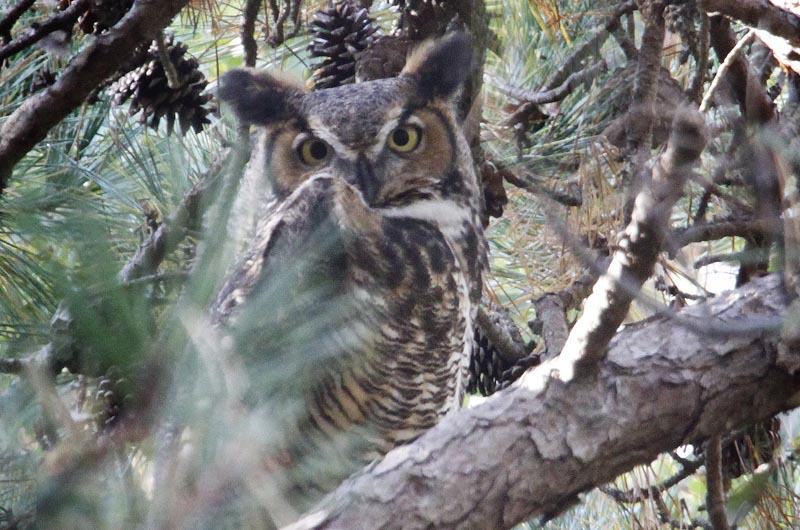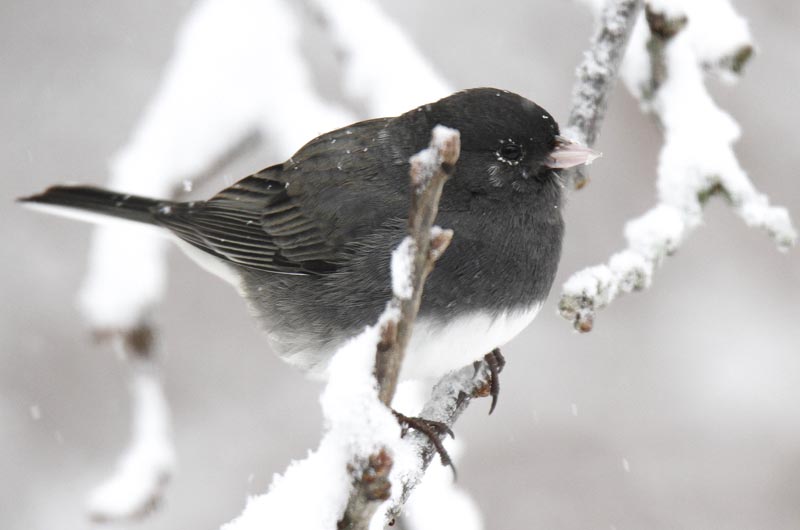I saw a definitive sign of the approaching spring on Thursday, March 12. Granted, it was only a flock of about 20 Canada geese, but they were landing on the football field at the high school. I would not have paid much attention to the geese except that I knew that the field had been buried under snow for the previous two months. Not coincidentally, the temperature had reached 52 degrees the day before. Most of the field was completely snow-free, which comes under the about time category!
We have had a considerable amount of warm weather since then, and more and more ground is emerging from the snow. Not everywhere though, my yard is on a north-facing slope and is still covered with about five inches of snow.

On March 15, Luanne Johnson won the award for hearing the first red-winged blackbirds singing in a marsh — their optimum nesting habitat. To quote her: “Yay for spring!” Jane Norton of Chilmark and Matt Pelikan of Oak Bluffs also report red-wings, but their location at feeders makes it more problematic to say whether they are winter residents or spring migrants.
And late breaking news! As I am writing this column, Vasha Brunelle announced the first of the year sighting of American oystercatchers, on Ferryboat Island in the west arm of the Lagoon, on March 16. Right on time, they always return in mid-March. And this site seems to always host the first sighting of the year; they are probably the oldest and most experienced of the oystercatchers, as younger birds tend to migrate later.
We will soon be hearing courting woodcocks, and reports of blooming snowdrops and crocuses. Welcome to mud season, where dirt roads and driveways change from ice-covered and frozen to muck and potholes.
Spring is here on the digital front too. March 6 marked the first of the spring bird migration forecasts (birdcast.info). This website is a treasure trove of information about bird migration across the continent. Based on weather forecasts, it predicts how heavy the migration might be for each day of the following week, and it predicts which species are most likely to be on the move. They added even more features for the forecast of the week for March 13 to March 20; they utilize past years of ebird data (ebird.org) to predict when migratory species will begin to arrive, when the migration will pick up its intensity, when it peaks, and finally, when the species will rapidly begin to depart for points north.
Bird Sightings
Cathy Minkiewicz reports that the white-breasted nuthatches reappeared just prior to the March 5 snowstorm. She still has a towhee visiting her feeder, along with other common species, although her dark-eyed juncos have moved on.
That March 6 storm also washed a lot of sea ice onto the north shore at Seven Gates Farm and elsewhere. Annie Schmidt observed some robins foraging in an unusual place, along the rocky ice-covered shoreline. The robins were foraging between the ice floes and the rocks along the shoreline, eating some stringy worm-like creatures. Sanderlings, more expected in this location, were also foraging in a similar manner. Wendy Culbert suggests that they were eating polychaete worms, which are abundant in intertidal and subtidal soft sediments. The underwater portions of the ice floes, which are much larger than what is above the water, might have scraped up some bottom sediments, including the worms, and the birds were taking advantage of this unusual location for food. Or perhaps these northern robins are simply used to feeding around ice in their northernmost breeding grounds. Or maybe they were desperate for food. Whatever the reason, it is an unusual place to find robins!
On March 11, Sharon Simonin spotted a red-necked grebe in Oak Bluffs harbor near the East Chop Beach Club. It provided another sign of spring, as it was pretty much wearing its breeding plumage of a sporty black cap and white cheek; it also had a substantial amount of red on its neck. We do not see that plumage very often, as they tend to head north while still in their bland winter plumage.
Jane Varkonda reports hearing both great horned owls and screech owls at her house off Meetinghouse Way in Edgartown on March 13. This is a little further east than their usual haunts in the State Forest. If there are two great horned owls calling back and forth, you may have a nesting pair and they are probably on eggs; they are early nesters and the eggs may even be hatching. Please email us if you hear any great horned owls, as we really do not know how many pairs there are on the Island.
Twenty-five robins have been visiting George Cowan’s feeder in Edgartown. They are still our wintering robins, which have been conspicuous this winter because the deep snow has forced them to frequent bird feeders and ornamental plantings in our yards. They may now return to the woodlands and fields, to their more natural foods that are no longer covered by the snow. Our spring migrants will announce their arrival by their song and by being paired off in your grassy yards.
There are lots of birds around, so please get out looking for them, and be sure to report your bird sightings to birds@mvgazette.com.
Robert Culbert leads guided birding tours and is an ecological consultant living in Vineyard Haven.





Comments (1)
Comments
Comment policy »